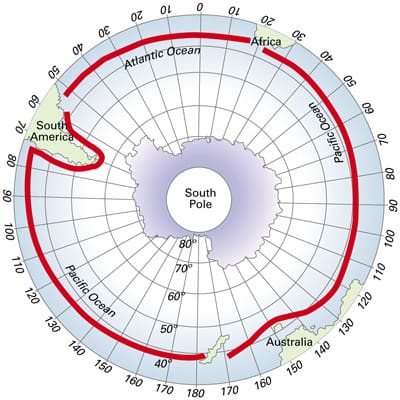There is only one single-handed sailor that I know of who has had a statue erected in his honor. That distinction belongs to the great, yet overlooked, Argentinean, Vito Dumas, who during World War II set out on his 32-foot double-ender and became the first solo sailor to round the three great capes of the world. The statue stands at the southern tip of South America, where, dressed in foul weather gear with a sou’wester hat snugly in place, the great Dumas looks out to sea.
Dumas, like Bernard Moitessier was a man in love with sailing boats and the sea. He was an accomplished painter, poet, cattle rancher, and a man of great faith who supposedly took only a screwdriver on his circumnavigation. He lost this sole tool somewhere along the way. A circumnavigation during the second world war must have seemed like madness, but Dumas was already age 42 and he figured time was short to achieve his dream.
His boat, a ketch-rigged Colin Archer type that he built in the 1930s, was named Legh (for the initials of his sweetheart) He departed Montevideo in June of 1942, sailing with no radio as he was concerned that if stopped at sea he might be thought a spy. Almost immediately he got into trouble, the hull sprung a plank, and Dumas injured his arm. The injury developed an infection that, despite injections of antibiotics, caused him agonizing pain. He become delirious and contemplated amputating his arm with an axe or his knife in order to stay alive. Before he set to that task, though, he passed out. When he awoke the wound had begun to drain. He later cut out the infected abscess.
Dumas arrived home 13 months later to a hero’s welcome. He was the first recipient of the first Slocum Prize awarded by the Slocum Society and was honored by the Royal Cruising Club of London. Perhaps his greatest contribution to solo sailing was eschewing heaving-to in the southern latitudes choosing instead to run before the waves.
Dumas continued sailing after the war and retired to an estate in Buenos Aires where he lived until 1965. Legh was given a place of honor in a national maritime museum. Dumas wrote of his exploits in his book Alone Through The Roaring Forties.
Of course, Dumas was a great celestial navigator, whose work at sea was spot on. An example for all of us who think that celestial navigation is outmoded and “quaint.” In our nav problem, we have him on his boat on June 18 somewhere off Cape Pillar, bound for Cape Horn. He is not sure how far south he is so he takes a noon sight to get an LOP (and a noon latitude line). He is at a DR of 54° 39’ S by 73° 37’ W. Height of eye is eight feet. There is no sextant error and there is no chronometer error. He shoots a lower limb shot of the sun at 16:56:20 GMT and gets an Hs of 11° 45.4’.
Extended answer by David Berson
The day is June 18, The DR is 54° 39’ S by 73° 37’ W. The height of eye is 8 feet. We are doing a lower limb sun shot to find noon. The time of the shot is 16 hrs 56 min. 20 sec. GMT. The Hs is 11° 45.4’
Declination at time of sight N 23° 25.3’
D corr is 0.0’
Final Declination is N 23° 25.3’
Hs 11° 45.4’
dip -2.8’
Ha 11° 42.6’
Ho 11° 54.1’
Latitude=90°-Ho=ZD+/- Dec.
90°
-11° 54.1’
78° 05.9’ ZD
-23° 25.3’
54° 40.6’ latitude

